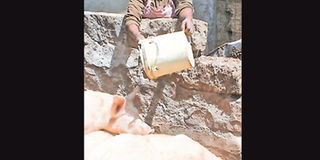Agriculture sector prospects brighter with new directives

A farmer feeds pigs. In recognition of agriculture sector’s role in economic growth, job creation and poverty reduction in the next 10 years, the ministry of agriculture unveiled the Agriculture Sector Transformation and Growth Strategy (2019) last year. PHOTO | FILE | NATION MEDIA GROUP
What you need to know:
- It has three priority action fronts - to raise the incomes of small-scale farmers, fisherfolks and herders, scale up agricultural output and value addition and boost household food resilience.
- Funds were also released to the National Cereals and Produce Board to mop up rice from farmers in the Kano and Mwea areas under the strategic food reserves agency.
- The facility in Ol Kalou would enable farmers to store their produce for up to six months to avoid flooding the market in peak harvest seasons, which drive down farmer earnings.
- Kenya’s arable land stands at 5.5 million hectares (ha) and only 160,000ha is under potato, producing some 2.9 million metric tonnes a year.
Agriculture is one of the main drivers of Kenya’s economic growth, accounting for 65 per cent of all exports, according to the Kenya National Bureau of Statistics.
In recognition of the sector’s role in economic growth, job creation and poverty reduction in the next 10 years, the ministry unveiled the Agriculture Sector Transformation and Growth Strategy (2019) last year.
It has three priority action fronts - to raise the incomes of small-scale farmers, fisherfolks and herders, scale up agricultural output and value addition and boost household food resilience.
To achieve the first goal, President Uhuru Kenyatta in January issued a directive to Treasury to release funds to the Agriculture ministry to mop up milk from small-scale farmers, set up new cooling plants and refurbish existing ones as well as pay farmers a reasonable rate for raw milk.
Funds were also released to the National Cereals and Produce Board to mop up rice from farmers in the Kano and Mwea areas under the strategic food reserves agency.
Some Sh3 billion was also allocated to the newly created Coffee Advance Cherry Fund to enable farmers to access credit to fund their activities.
To scale up agricultural value addition and boost food resilience, the President has targeted food-processing and leather manufacturing sectors. The two industries offer low-hanging fruits for the Big Four agenda.
To actualise this, in February, President Kenyatta rolled out a new potato value addition programme in Nyandarua County.
This is the first of three such facilities the government planned to set up by June at a cost of Sh100 million each.
BOOSTING EFFICIENCY
The facility in Ol Kalou would enable farmers to store their produce for up to six months to avoid flooding the market in peak harvest seasons, which drive down farmer earnings. A recent report by the USAid-funded Kenya Agricultural Value Chain Enterprises indicate demand for potatoes tripled between 2004 and 2014 due to urbanisation.
But it is Egyptian, South African and European potato farmers, not Kenyans, who are filling the gap. Kenya’s potato varieties are of poor quality, the reason global fast-food chains are importing the produce.
Kenya’s arable land stands at 5.5 million hectares (ha) and only 160,000ha is under potato, producing some 2.9 million metric tonnes a year.
The bulk of this farming is done by some 800,000 small-scale farmers, representing 83 per cent of potato farmers.
To turn around the low-quality seed puzzle, the Ministry of Interior, the National Youth Service, the Kenya Prisons Correctional Services and Kenya Agricultural and Livestock research Organisation, among other State agencies, have partnered to develop new high-yielding potato seed varieties on a massive scale in the next two to three years.
Once in full implementation, the prospects for boosting efficiency in food production to meet nutrition needs for the nation, increased income for farmers and poverty reduction impact are enormous.
In addition, the utilisation of NYS trainees and prisoners in the innovation offers prospects to make the cost of developing the seeds minimal and affordable to farmers.
An unexpected and perhaps more enduring spin-off from the entire programme are the thousands of inmates and NYS youngsters likely to gain useful modern farming skills to join the ranks of the next generation potato producers.
The writer is a media commentator; [email protected]





